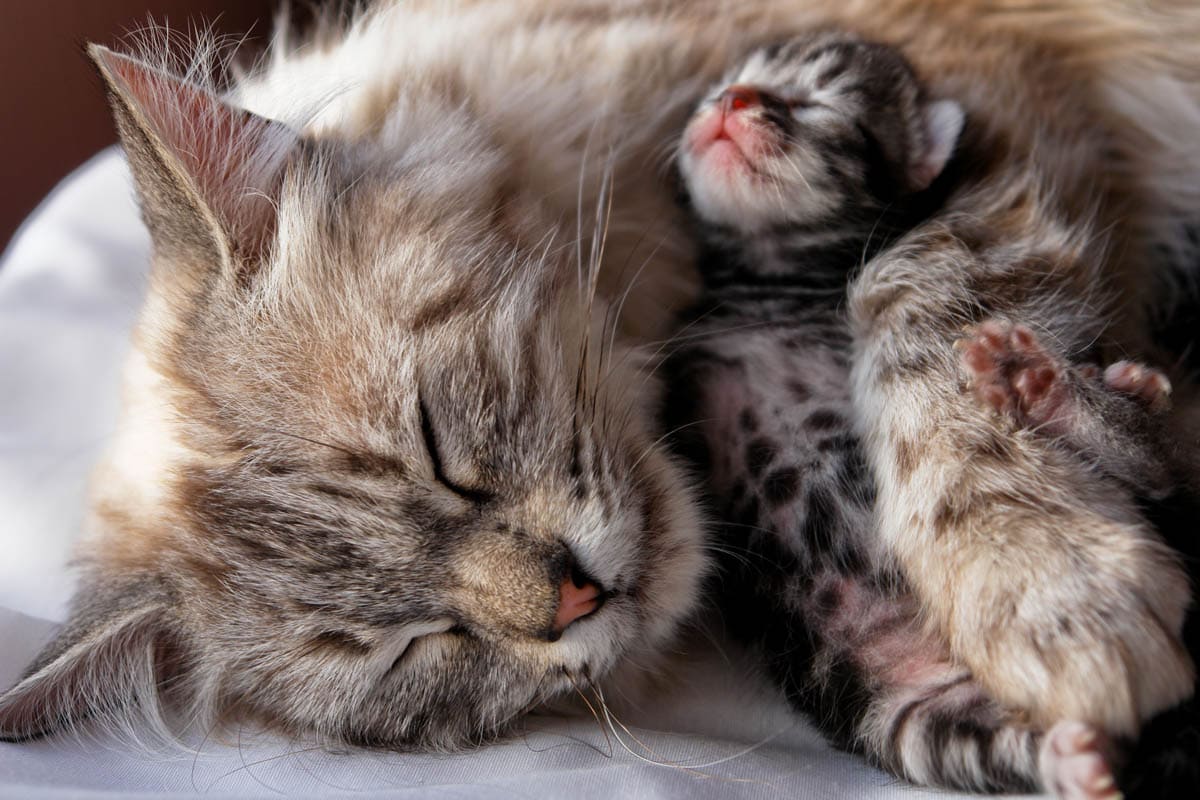Most queens (mother cat) require little or no assistance during the delivery and can successfully raise a litter without our assistance. However, the prudent carer should be aware that there will be some requirements to help the queen stay healthy and well so she can care for her new family.
Immediately after the birth
Count how many placentas have been delivered, there should be one placenta per kitten. If you are not sure that they have all been delivered, check with your veterinarian.
Once the kittens have been born, replace soiled bedding.
General Care
Provide the queen with a quiet, safe comfortable, warm area to care for her kittens. The new mother will rarely leave the nest in the early days.
Within 24 hours of the birth, the queen should see a veterinarian for a check-up. The veterinarian will be able to feel for any undelivered kittens and make sure everything is healing as it should. A small amount of vaginal discharge is present for 7 – 10 days post queening. The discharge is reddish-brown in colour and should not be odorous.
- Foul-smelling discharge
- Bright red discharge
- Profuse discharge
- Discharge lasting longer than three weeks
Feeding during lactation
Offer the queen a meal once she has delivered her kittens.
A lactating queen will need to consume two to three times the number of calories that she required before becoming pregnant. Without these additional calories, she cannot produce enough milk to feed her kittens. She should be provided as much food as she wants and has constant access to fresh water.
Feed the kittens a high-quality food designed for kittens.
Postpartum complications
- Postpartum hemorrhage: Some discharge is normal, but if the discharge is bright red, or there is an excessive volume seek immediate veterinary help.
- Mastitis: Mastitis (inflammation of the mammary gland) occurs when the lactating queen’s mammary gland(s) becomes inflamed, blocked or infected. Symptoms include pain, heat, and swelling of the affected gland(s), fever, milk may be bloody, yellow or thick, the queen may refuse to let her kittens nurse from the affected gland, the queen may become depressed and lose her appetite and become dehydrated, lethargy, sick or dying kittens.
- Acute metritis: This is inflammation of the lining of the uterus (endometrium) postpartum, usually due to a bacterial infection. Symptoms include lethargy, vomiting, diarrhea, anorexia, fever, foul-smelling, dark discharge from the vagina.
- Agalactia (complete lack of milk supply) and dysgalactia (decreased milk supply): This can be due to inadequate nutritional support of the queen, large litter size, deformed nipple(s) or occasionally caesarean sections. Encourage kittens to nurse as this assists with milk production. Fresh drinking water should be available at all times, and she should be provided with as much high-quality food as she wants. By the second week of lactation, she will require up to three times the amount of calories as a nonpregnant cat. Kittens may cry and fail to thrive. Your veterinarian may recommend you supplement the litter or he may prescribe a medication to assist with milk production or both.
- Eclampsia (milk fever, puerperal tetany): This life-threatening condition occurs when the levels are depleted in the lactating queen resulting in hypocalcemia. Signs of eclampsia include restlessness, anorexia, walking with a stiff gait, high temperature, increased respiration rate, trembling, convulsions.
What to look out for
- Fever
- Loss of appetite (anorexia)
- Lack of interest in kittens
- Odorous vaginal discharge lasts longer than three weeks or excessive bleeding
- Swelling, heat or discomfort from the breasts
If you notice any of the above, seek veterinary help immediately.
Pregnancy
A female cat can come into heat soon after birth, keep her inside and away from entire male cats to prevent pregnancy.

